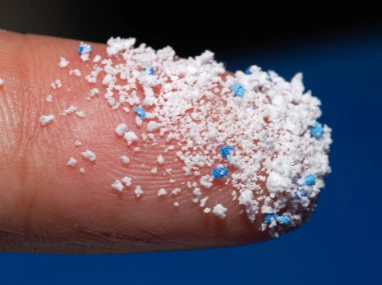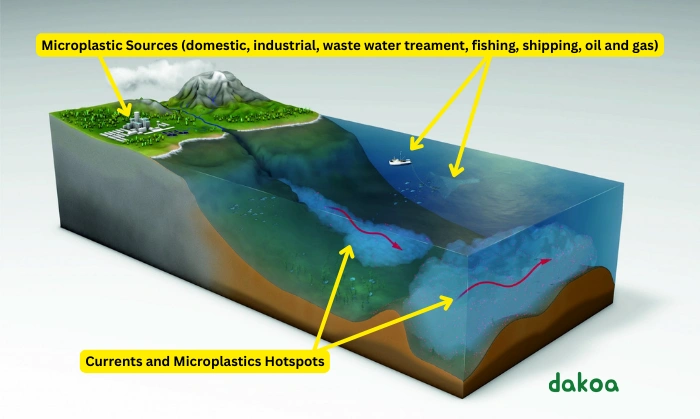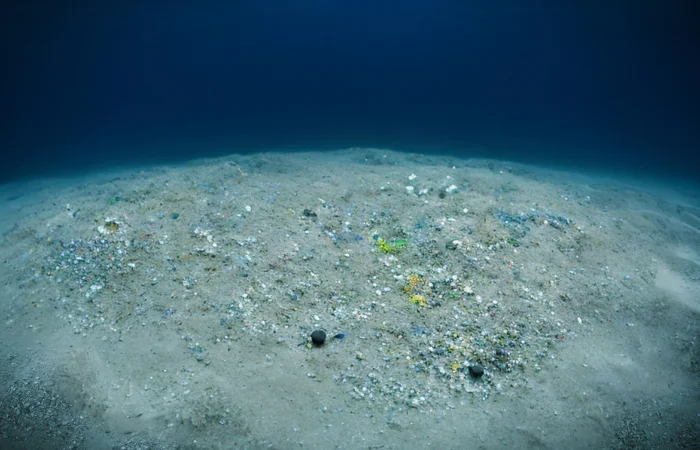The problem of plastic pollution in our oceans has been a subject of global concern, impacting beaches, sea life, and even reaching the remotest parts of our planet, such as the deep ocean and Antarctica.
The scale of this issue has been brought to light in a groundbreaking study conducted by CSIRO, Australia’s national science agency, which was published in the journal Frontiers in Marine Science.
This comprehensive research provides a startling revelation, estimating that approximately 14 million metric tons of microplastics are currently residing on the ocean floor.
This figure is staggering, standing at over thirty-five times the amount of plastic believed to be floating on the ocean’s surface, highlighting the gravity of the situation beneath the waves.
Microplastics, defined as small plastic fragments less than five millimeters or 0.19 inches in size, are the focus of this study. The researchers have conducted the first global approximation of microplastics located on the sea floor, painting a clear picture of the extent of damage caused by plastic pollution.
To gather the necessary data for this in-depth analysis, the team employed a robotic submarine, which was instrumental in collecting sediment samples from depths of up to 3,000 meters or 9,800 feet.
The samples were retrieved from six different locations within the Great Australian Bight, situated approximately 380 km or 236 miles off the coast of South Australia.
An analysis of fifty-one sediment samples revealed an alarming rate of microplastic contamination, averaging 1.26 microplastic particles per gram of sediment. This density of pollution is reported to be up to twenty-five times higher than what has been observed in previous deep-sea studies, underscoring the severity of the problem.
Justine Barrett from CSIRO’s Oceans and Atmosphere unit, who spearheaded the research, shared her insights in an official statement. She expressed her concern, stating that even the profound depths of our oceans are not immune to the plastic pollution crisis.
She highlighted that once plastic enters our oceans, it breaks down and degrades, ultimately transforming into microplastics which then sink to the ocean floor.
This study serves as a grim reminder that the situation is likely to worsen in the years to come, with plastic production and pollution projected to increase significantly. The need for urgent action and solutions to mitigate the impact of plastic pollution has never been more critical.

But Is It Really a Cause For Alarm? Why Microplastics Are a Major Concern
Microplastics, often invisible to the naked eye, are lurking beneath the ocean’s surface, weaving a web of destruction that affects marine life, ecosystems, and potentially human health. But what exactly are these tiny particles, and why are they causing such alarm among scientists, environmentalists, and policymakers worldwide?
Microplastics are small plastic fragments less than five millimeters in size, originating from a variety of sources. They can be the result of larger plastic debris breaking down over time due to sunlight, wind, and wave action, or they can be directly released into the environment as microbeads found in personal care products, synthetic fibers from clothing, and industrial pellets.
Once they enter our oceans, microplastics become pervasive, circulating through water currents, sinking to the ocean floor, and even becoming suspended in the water column. Their small size makes them easily ingestible by marine organisms, from tiny plankton to large fish, thus infiltrating the marine food chain.

The harm caused by microplastics is multifaceted. Physically, they can lead to internal abrasions, blockages, and reduced feeding in marine animals, ultimately impacting their growth, reproduction, and survival.
Chemically, microplastics can act as sponges, absorbing and concentrating toxic pollutants from seawater. When ingested by marine life, these toxins can accumulate and potentially move up the food chain, reaching higher concentrations in predator species.
Furthermore, microplastics pose a potential threat to human health. Seafood is a major source of protein for billions of people worldwide, and as microplastics enter the food chain, there’s a growing concern about their implications for human health.
While the full extent of these impacts is still under investigation, the ingestion of microplastics through seafood consumption could potentially lead to exposure to harmful chemicals.
The presence of microplastics in our oceans is also a stark indicator of the larger issue of plastic pollution.
Each year, millions of tons of plastic enter our oceans, contributing to habitat destruction, entanglement, and ingestion by marine life, and the alteration of marine ecosystems. Microplastics, due to their small size and persistence, are a particularly insidious component of this pollution.
As the global community grapples with the plastic pollution crisis, understanding the nature of microplastics, their pathways into the ocean, and their impacts on marine life and human health is crucial.
More To Discover
- MIT Paves Way for Next-Gen Solar With Guide On Commercializing High-Energy Perovskite Cells
- NY Attorney General Sues Pepsi Over Alarming Plastic Pollution in Buffalo River, Endangering Public Health and The Environmental
- A Common Laundry Detergent Enzyme Can Recycle Single-Use Plastics In 24-Hours, Researchers Discover
- Federal Regulators Tackle Meat Industry Monopolies with New Rules
This knowledge is essential for developing effective strategies to mitigate their presence in our oceans and safeguard the health of our marine ecosystems and, ultimately, ourselves.
Source: Frontiers of Marine Science



















